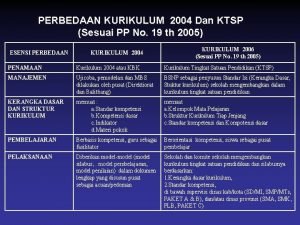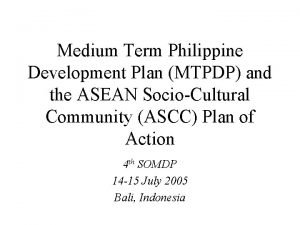NATIONAL DEVELOPMENT PLAN 2004 2006 Expost evaluation of











- Slides: 11

NATIONAL DEVELOPMENT PLAN 2004 -2006 Ex-post evaluation of HRD OP 3. 2. measure „Contentwise, methodological and structural development of vocational education” 3. 2. 2 submeasure: Setting up Regionally Integrated Vocatinal Training Centers (RIVTC) Expanzio Consulting Ltd. Dr. Setényi János

The background of evaluation • Framework contract on evaluation with the National Development Agency • Fast-track offer and contract with NDA on the evaluation of RIVTC in the October of 2009 • Evaluation work and preliminary consultations

What are the regionally integrated vocational training centers?

Goals and motivations behind the RIVTCpolicy • Concentrating the previously atomized and expensive training capacities – consortia of schools, HEIs and local governments • Providing modern practical training on the basis of brand new infrastructure • Integrating HRD and ERD resources into regional development • Missing: increasing the control of economy over vocational education

The evaluation task • Strategic evaluation (ex-post) on the outcomes and sustainability of RIVTC development programme (2004 -2006) • Document analysis (mid-term reports), data analysis (EMIR on-line system) and field work (interviews and visits)

Some evaluation questions • Were the defined goals and outcomes reached by the implementors? • What organizational development was achieved by the 16 RIVTCs? • How efficiently are used the practical training centers? • How efficiently are used the new capacities of the training centers? • What are the impacts of the new training centers on the quality of practical training of students? • What kind of positions were gained by the new training centers in the regional market of adult education? • How did the cooperation of training centers and HEIs change in the course of the implementation?

Scope and methods • Data survey and document analysis • Survey (approached 16 RIVTCs, only 9 answered) • Interviews (with 33 project managers and teachers plus 2 programme designers) • Four evaluation questions can’t be answered in an obvious way

Outcomes The most fundamental goals were achieved: • Modern centers of practical training were built – but the old capacities partly survived in the schools, • RIVTCs were particularly successful to create additional services for students like career orientation, personal guidance and development, additional trainings and social services – but these services were only covered by the project budgets, • Modern student registration and school management systems were created – but the actual decision-making power remained at the school level.

Half way there?

The main conclusion: a measure without a character • As a system-building venture the measure has created additional and poorly integrated training capacities; • As a policy-reform the measure was not accompanied by supporting legislation and regulation; • As an innovation, the measure was too large and expensive.

Recommended conditions of a sustainable system of RIVTCs: national level • New funding system which can push through the rationalization of schools and the central position of RIVTCs in the consortia. • Urgent inclusion of the corporate sector into the RIVTC consortia • Rigorous separation of secondary general education (schools) and vocational training, the latter should be concentrated in the training centers • Independent vocational examination of students (regional examination centers)





















